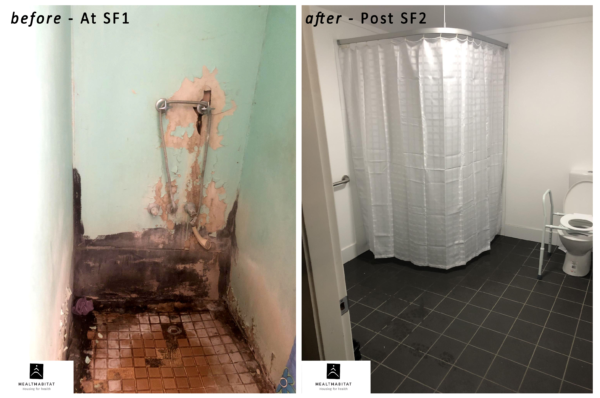REAL WORLD EXAMPLE: HLP1 – Shower Failure
Over the past 20 years of Housing for Health, project teams have witnessed many failed showers – one of the most important pieces of Health Hardware in a house.
All parts of the shower should be designed, built and maintained to enable people to wash themselves at least once a day. The shower contains a number of interdependent parts that must be working to provide benefit to the residents of the house.

Real World Shower Example from a recent project
Housing for Health – The Guide tells us:
- if shower bases and walls are not completely waterproofed, water will penetrate the walls and damage the supporting floor structure (29 per cent of walls show signs of water penetration)
- if floors do not fall to floor drains (29 per cent floors not drained an improvement of 5 per cent since 2006), water will pond, make the floor less safe and more difficult to clean
- shower trays, hobs and showers over baths can limit accessibility for elderly people and people with disabilities (50 per cent of houses that have a bath have a combined shower and bath)
This Real World Example from a recent project shows:
- A hob means it is difficult for the elderly tenant to access the shower safely
- The shower cubicle’s waterproofing has failed (or was faulty at time of installation) and so has over time rotted the wall lining and structure
- The wall lining around one of the taps has failed exposing the in-wall breech piece, possibly due to a leaking tap from hard water OR failure to seal behind the tap flange allowing water to run into the cavity
- Both shower taps are missing Hot and Cold indicators, a danger especially when children are using the shower
- The shower floor surface has become unsafe due to loose floor tiles and grout
- Loose floor tiles have compromised the floor drain, it has dropped and lost the grate cover to prevent soap or debris blocking the plumbing line
- Due to water penetrating the wall cavity and poor ventilation, serious mould has developed, which could in turn increase respiratory and sinus concerns of tenants
This illustrates the importance of localised Design and Specification, along with good Construction and inspection of all works to ensure no defects and regular maintenance over the life of a building.
Working with the elderly tenant and the local trades, a new accessible bathroom designed to the Design and Specifications as documented in The Guide was constructed to the relevant accessibility standards (AS1428.1) to improve the health of the occupants.









